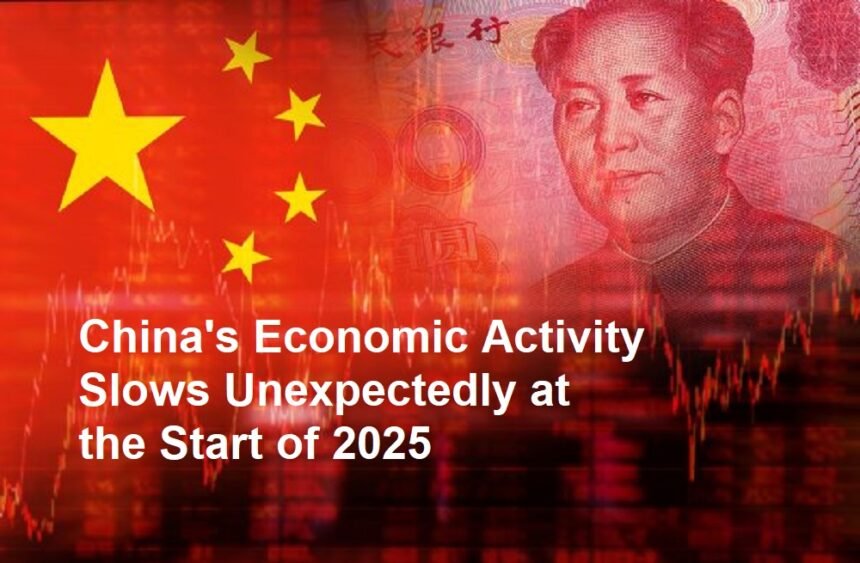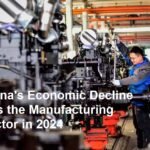China’s economy, which showed signs of resilience in late 2024, has experienced an unexpected slowdown at the beginning of 2025. According to the latest data, factory activity in China contracted in January 2025, ending a streak of three consecutive months of expansion. This development has raised concerns about the country’s recovery trajectory amid persistent global and domestic challenges.
The slowdown highlights the fragility of China’s economic rebound, which has been supported by government-led stimulus efforts and a moderate recovery in consumer spending. As external demand weakens and structural issues within the domestic economy persist, analysts are revisiting their growth projections for the world’s second-largest economy.
Factory Activity Contracts in January
The contraction in factory activity was reflected in the Purchasing Managers’ Index (PMI), a key indicator of manufacturing health. The PMI fell to 49.3 in January 2025, down from 50.4 in December 2024, indicating a contraction in manufacturing output. A reading below 50 signifies shrinking activity, while a reading above 50 indicates expansion.
This decline surprised many economists, who had anticipated continued expansion following three months of growth in late 2024. The drop was attributed to multiple factors, including weak export demand, declining orders, and rising costs for raw materials and labor.
Global Demand Weakens
A significant factor contributing to the slowdown in China’s manufacturing sector is the decline in global demand for Chinese goods. Major export markets, including the United States and the European Union, have been grappling with their own economic challenges, including high inflation, sluggish growth, and geopolitical uncertainties.
Exports, which account for a substantial portion of China’s GDP, saw a decline in January, particularly in categories such as consumer electronics, machinery, and textiles. This marks a sharp contrast to the pandemic years, when global demand for Chinese goods surged due to disruptions in other supply chains.
In addition, the ongoing decoupling efforts by Western nations to reduce reliance on Chinese supply chains have further exacerbated the slowdown. Companies in the U.S. and Europe have increasingly sought alternative manufacturing hubs in Southeast Asia and India, impacting China’s export competitiveness.
Domestic Challenges Add Pressure
While global factors have played a role, China’s domestic economy also faces significant headwinds. Consumer confidence remains fragile, with households hesitant to spend amid lingering uncertainty about the labor market and economic stability. Despite efforts by the government to boost domestic consumption, spending levels in January 2025 were weaker than expected.
Another challenge is the ongoing weakness in the property sector, a critical pillar of China’s economy. The sector remains mired in a debt crisis, with major developers struggling to complete projects and deliver promised housing units. This has dampened investment and contributed to reduced demand for construction materials and related goods, further impacting factory activity.
Government Response to the Slowdown
In response to the unexpected slowdown, the Chinese government has pledged to step up measures to stabilize the economy and support growth. The Ministry of Industry and Information Technology announced plans to provide additional tax breaks and subsidies to struggling manufacturers, particularly small and medium-sized enterprises (SMEs).
The People’s Bank of China (PBOC) has also hinted at the possibility of monetary easing, including reducing interest rates or lowering reserve requirements for banks, to encourage lending and investment.
Additionally, the government has reaffirmed its commitment to boosting domestic demand as a key driver of growth. Initiatives such as increased infrastructure spending, incentives for consumer purchases, and targeted assistance for the property sector are expected to play a central role in China’s economic policy for 2025.
However, economists remain cautious about the effectiveness of these measures. Structural challenges, including high corporate debt levels and declining productivity, require longer-term solutions that go beyond short-term stimulus.
Economic Outlook for 2025
The unexpected contraction in factory activity at the start of 2025 has led to a reassessment of China’s economic outlook for the year. While the government’s official growth target has not yet been announced, analysts are predicting a GDP growth rate of around 4.8% to 5.2%, down from the 5.5% forecast made in late 2024.
Key risks to the outlook include:
- Prolonged Weakness in Global Demand: If external markets continue to struggle, China’s export sector could face ongoing challenges.
- Slow Recovery in Domestic Consumption: Without significant improvements in consumer confidence, domestic demand may not be strong enough to offset external pressures.
- Property Sector Instability: Continued uncertainty in the real estate market could weigh on overall economic growth.
Despite these risks, some sectors are expected to perform well in 2025. High-tech manufacturing, green energy, and electric vehicles are likely to benefit from government support and rising global demand.
China’s unexpected economic slowdown at the start of 2025, marked by a contraction in factory activity, underscores the challenges facing the country as it navigates a complex economic environment. Weak global demand, domestic headwinds, and structural issues have created significant obstacles to sustained growth.
While the Chinese government is stepping up efforts to stabilize the economy through stimulus measures and policy adjustments, the effectiveness of these initiatives remains to be seen. As the year progresses, all eyes will be on whether China can overcome these challenges and maintain its role as a key driver of global economic growth.
For now, the slowdown serves as a reminder of the fragility of the global economy and the interconnected nature of economic challenges in today’s world.













